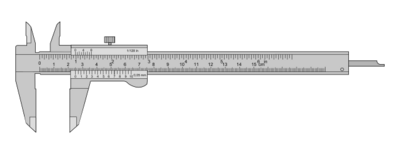Biography:Pierre Vernier
Pierre Vernier (19 August 1580 at Ornans, Franche-Comté, Spanish Habsburgs (now France) – 14 September 1637, same location) was a French mathematician and instrument inventor. He was inventor and eponym of the vernier scale used in measuring devices.
Life

He was born in Ornans, France, in 1580, he was taught science by his father. He later became captain and castellan of the castle at Ornans, for the King of Spain. He was also later councillor and director general of economy in the County of Burgundy.
In Brussels, in the year 1631, Vernier published, his treatise La construction, l'usage, et les propriétés du quadrant nouveau de mathématique, and dedicated it to the Infanta. In it he described the ingenious device which now bears his name, the vernier scale.[1]
To a quadrant with a primary scale in half degrees Vernier proposed to attach a movable sector, thirty-one half degrees in length but divided into thirty equal parts (each part consisting then of a half degree plus one minute). In measuring an angle, minutes could be easily reckoned by noticing which division line of the sector coincided with a division line of the quadrant.
Christopher Clavius had earlier mentioned this idea but had not proposed to attach the scale permanently to the instrument.
The name vernier is now applied to the small movable scale attached to a caliper, sextant, barometer, or other graduated instrument and was given by Jérôme Lalande. Lalande showed that the previous name, nonius after Pedro Nunes, belonged more properly to a different contrivance. The name nonius continued to be applied to the vernier until the beginning of the 19th century.[2]
Notes
- ↑ Chisholm 1911.
- ↑ Daumas, Maurice, Scientific Instruments of the Seventeenth and Eighteenth Centuries and Their Makers, Portman Books, London 1989 ISBN:978-0-7134-0727-3
References
 Linehan, Paul Henry (1912). "Pierre Vernier". in Herbermann, Charles. Catholic Encyclopedia. 15. New York: Robert Appleton Company.
Linehan, Paul Henry (1912). "Pierre Vernier". in Herbermann, Charles. Catholic Encyclopedia. 15. New York: Robert Appleton Company.
External links
- O'Connor, John J.; Robertson, Edmund F., "Pierre Vernier", MacTutor History of Mathematics archive, University of St Andrews, http://www-history.mcs.st-andrews.ac.uk/Biographies/Vernier.html.


